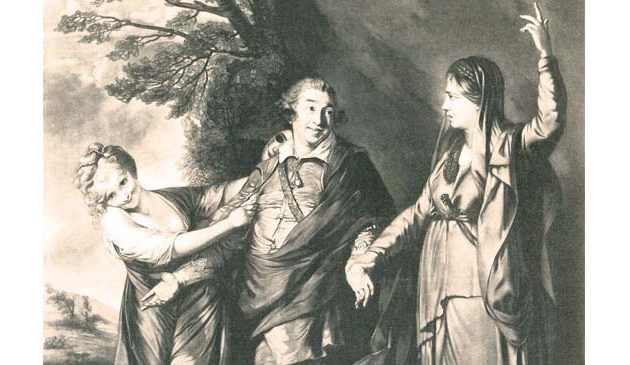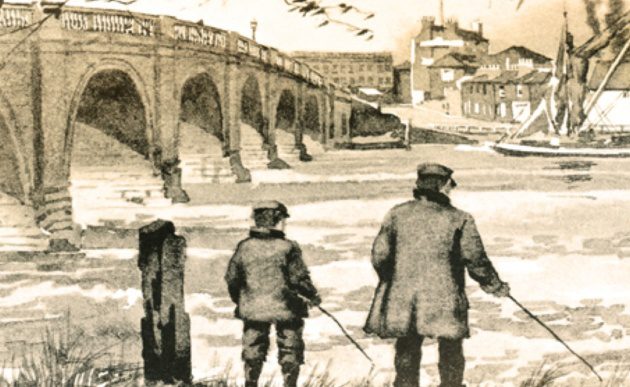The Bow Street Runners – the emergence of policing in London

The Bow Street Magistrates Court is crowded with people waiting to be heard by the magistrate, as depicted in 1808 by Thomas Rowlandson. The magistrate sits on a podium to the left.
London, home to a tenth of the country’s population in the 18th century living in quite a small area, and with overcrowded pockets of squalor, faced unique social problems. Crime was rampant, yet there was little effective organisation to combat it. Each of the separate and overlapping authorities responsible for the governance of the metropolis had different structures for dealing with the problem, with almost no co-ordination between them.
In 18th century London there was increasing wealth for some but also a growing number of poor and unemployed. The old social orders of earlier times were breaking down. The metropolis was a magnet for immigrants from other parts of the nation, seeking employment but often without success. Thousands of men were discharged from the armed forces in 1748 after the end of the War of Austrian Succession, many without a chance of employment. Without a settled home in the city people were excluded from financial support from a parish. Poverty and crime were also fueled by the craze for drinking gin. Those who could not or did not want to support themselves lawfully turned to crime, of which there was little control. Pickpockets and footpads operated throughout the metropolis and highwaymen took advantage of those travelling on the roads to and from London.
Magistrates had the power of summary jurisdiction to punish those found guilty for a specified list of minor offences, with a fine, whipping, or commitment to a house of correction. The number of these specific offences grew throughout the century as new laws were passed by Parliament. Those suspected of more serious crimes were sent to prison to await trial by jury at the Old Bailey criminal court. Offences for which a magistrate could convict included various types of vice, drunkenness and different kinds of disorderly conduct, selling ale without a licence, working on Sunday, swearing, vagrancy, disobedience by servants, some types of petty theft, assault, and vagrancy.
It was the responsibility of constables and night watchmen to apprehend criminals. The latter were often elderly and decrepit, armed only with a staff and lamp. The majority of constables were known to be corrupt.
Covent Garden in particular had a reputation for high levels of crime. The district had been created in the 17th century on the land of the Duke of Bedford to the west of the City of London as a new suburb for the affluent classes. A century later those of wealth had moved on to the new and more fashionable suburbs of St. James’s and Mayfair. As the aristocracy moved out the area became a place of both legal and illegal pleasures. Thieves and con men hung around Covent Garden’s two theatres to prey on unsuspecting theatre-goers. The area was notorious for its brothels and prostitutes on the street. A number of illegal clubs for homosexuals – ‘mollies’ – also operated in the area, as did illegal gambling houses. Around 30,000 of the city’s poorest people lived in the nearby slums of St. Giles, a large number of whom had no means of supporting themselves except through begging or criminal activity.
Without any effective crime-detection the best way to retrieve stolen goods was to place advertisements in newspapers giving descriptions of perpetrators and goods and offering rewards. Money was paid to informants and from the end of the 17th century this became institutionalized in the role of ‘thief-takers’. They were individuals who theoretically earned a living from solving crimes but were often little more than criminals themselves. The smartest of them simply stole goods in order to claim back the reward for their return. The main motivation for thief-takers was to obtain the reward, not whether the accused was innocent or guilty, and many false and malicious prosecutions took place. The most famous thief-taker was Jonathan Wild, who became known as the ‘Thief-Taker General’. If your property was stolen there was a strong chance Wild could find it for a reward and he ensured that any thief who did not cooperate with him went to the gallows. His scheming was eventually uncovered and he was hanged at Tyburn in 1725. Despite Wild’s corruption he was at least keeping some control of London’s criminal network. After his execution there was for several years a gap in crime detection.


